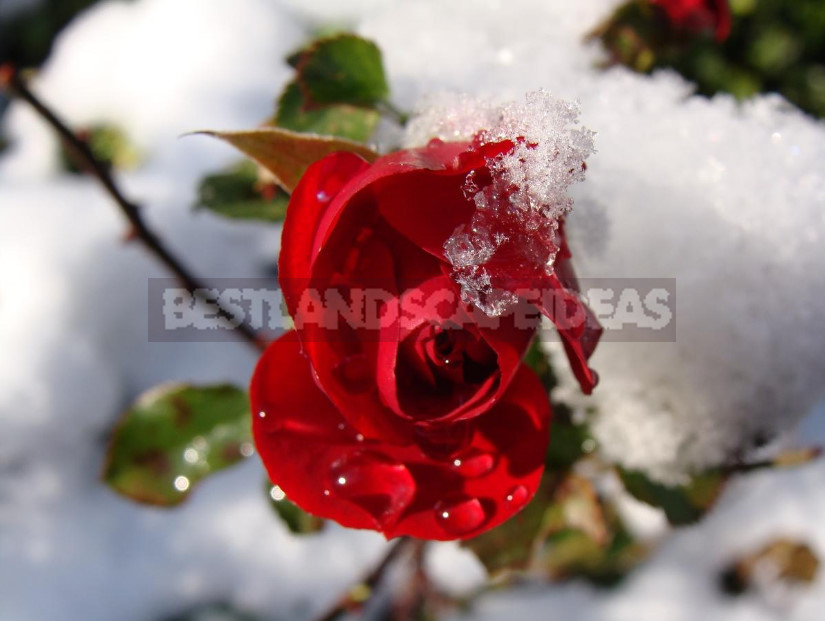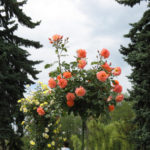Each Amateur can have his own technique of covering roses, proven experience. I had to read articles which is able to simply scare the newbie frightening complexity. If today I proceeded from such advice, I would not have planted a single rose, not to mention the collection of 350 varieties.
I know for sure the shelters of stamp roses in the form of houses made of timber with additional insulation, which killed beautiful and healthy specimens. At shelter of any roses it is necessary to proceed from the fact that the main heater is a good snow cover, and your task consists in the competent organization of snow retention. I am convinced, that roses in most die not from frosts, and from your the strange love to them (in the damage their health).
What is winter hardiness? This is a complex breeding sign, reflecting the ability or inability of plants to resist a complex of adverse effects during the winter period (the effect of low temperatures, squeezing, soaking, evaporation, exposure to ice crust, etc.). If we start to analyze all these factors, we will be surprised to learn that rose can die not only from frost, but even from exhaustion or poisoning of the body.
Rose after the fall crop not ripe parts of the shoots gradually bend down, locking tilt. When choosing stem roses, remember that the lower the stem, the more problems. Young strains, primarily weeping forms, bend down easily, especially if the landing was provided a slight slope in the direction of bending. Old copies to avoid the risk you can gently dig under.
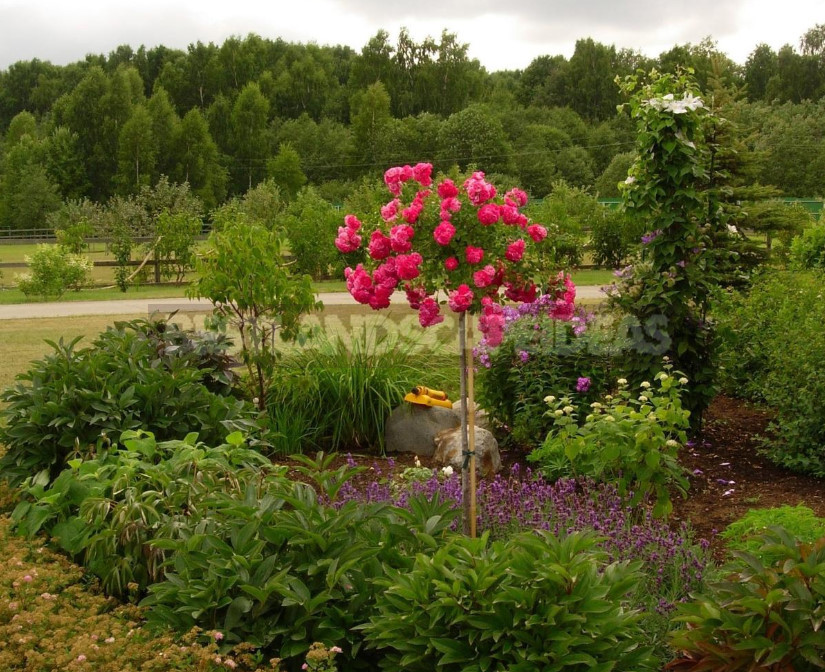
Because of the recent fascination these roses have acquired a mass character, I’ll digress for further explanation. I am often asked about what rose is considered an old copy. It is very difficult to answer this question without seeing the plant. It often happens that it can be considered as such almost immediately.
This depends, first of all, on the characteristics of the stock: not everyone is suitable for a stamp rose. To grow it, it takes 4 to 5 years, and all this time it requires attention. Accelerated technology reduce the quality and durability. I have never dug up my stem roses, and they grow in me from 6 to 8 years. There are roses with such heavy crowns that only it is necessary to detach them from the support, as they, forgetting about age, themselves tend to the ground. However, it will continue.
The crown should be laid on the Mat of spruce branches and cover the top of the spruce branches in the form of a light tent. To cover is not blown away, hut better to fix the solid piece was lutrasil and multiple metallic arches.
I have to deviate from the topic again, because the problem of spruce branches is already becoming threatening for our forests. First, I want to say that you can go directly to the forest, there just in this period are sanitary felling, and they are willing to sell such a spruce branches. Foresters clean the forest and have some profit, and we have a clear conscience.
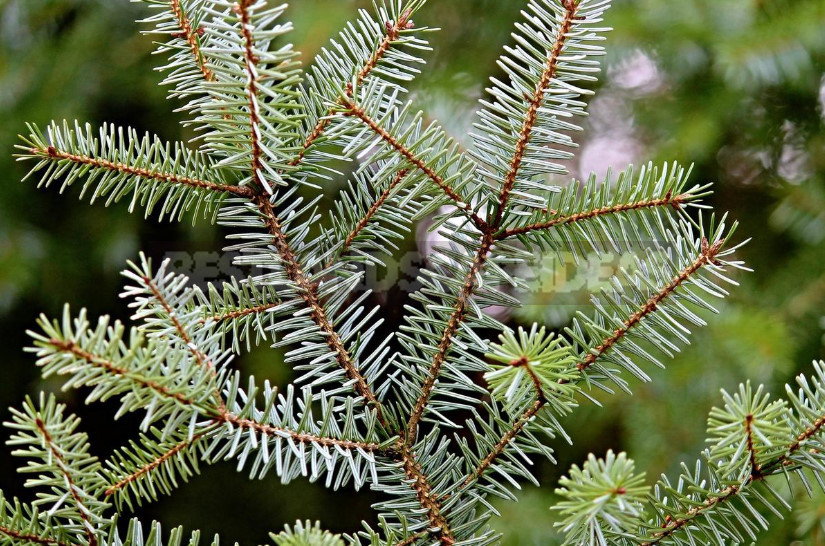
Secondly, it is impossible to proceed from the erroneous premise that it warms the spruce branches. In fact, it’s just the best material for snow retention. Roses need a small air chamber and a roof over it from loose snow.
In the absence of twigs is not a city sealed the shelter of the boxes, film or roofing material, rose in them will become warmer and suffer from exposures it will start if not from the moment of the shelter, with the first thaw. Remember that any design should provide self-ventilation (without your participation).
Put a few bricks and build a rarefied flooring of scraps lining impregnated with antiseptic, lay it on the crown and fix. Install over the crown of the arc (only not too high) and pull on them a sturdy lutrasil. On top of the snow guard to put the branches that remain from the pruning of other shrubs. Suitable even brushwood, which can be collected in the forest. An important drawback of such shelters-their untidiness in the spring. To fix it, use its branches to decorate shelters.
Some experienced gardeners recommend to fill the crown with light clay soil. I emphasize that this is done by experienced gardeners. Tips to fill the earth (especially peat) inside and the top sealed films or roofing material find worthless meaning, no complexity, and I even wonder how eagerly they follow. I do not rule out that the roses in this case can overwinter, but I am sure that you need to live next to them and grieve only their concerns.
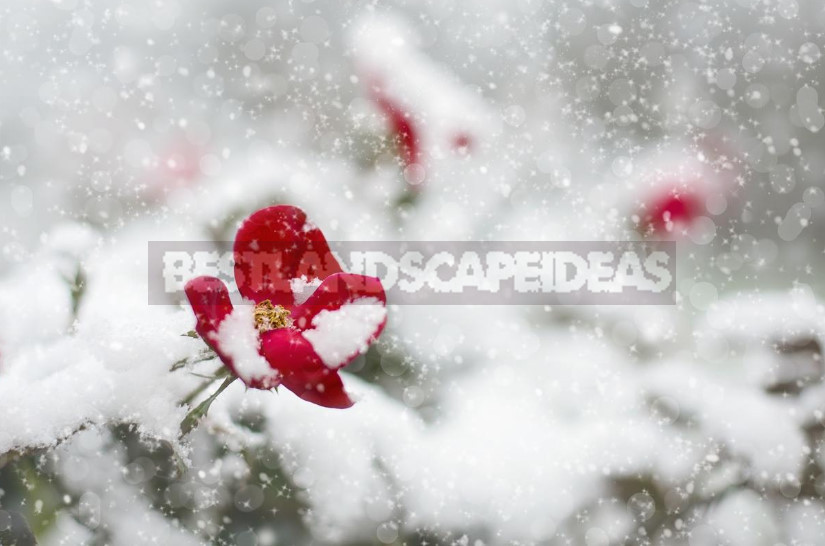
If you plant roses on your site with the expectation of joy, you still have to proceed from the fact that it is they-for you, not you – for them. Excessive care sometimes spoil even children, not to mention roses. In addition, now very different roses, and these tips could just get old.
It is not necessary to hurry with shelter, the first frosts will not damage, and will help aging of wood and a leaf fall, and also hardening of plants. As a rule, roses are finally sheltered not before the end of the first decade of November, although I remember the year when I sheltered them in the middle of December.
Miniature stamp roses are grown more often in containers and in the winter are removed in unheated rooms. If this is not possible, they are dug obliquely along with the container into the ground (of course, the crown is not buried) — in this way you just immediately reach the end of the painful operation for you to bend, especially since the miniature strains can not be bent. I think this is the best option, because when stored in basements it is difficult to provide the desired temperature, roses often move ahead of time in growth and need attention.
In General, as for the roses in the containers, I prefer 10 stamp roses in the ground one in the container. At least, I do not advise to start with them. In addition, many varieties of miniature roses and are not designed for open ground, and some are just unhealthy. No one will convince me otherwise — I have been caring for a collection of almost 100 varieties for several years and as a result came to a difficult decision to part with it completely.
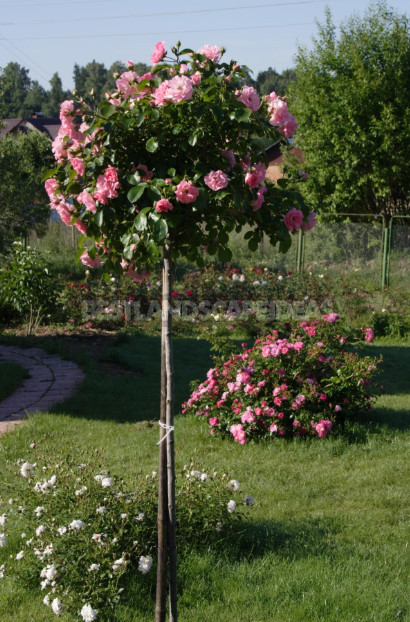
In the spring of late March-early April, compacted snow from the shelter to remove, and to remove water to make grooves. At the first opportunity and at any constructions of shelters it is important to provide access of air to plants (to ventilate that overwintered rose under it did not grow out). When the snow comes down completely and begins to thaw the soil, you need to gradually remove the shelter, it is better to do it in cloudy, windless days.
The exposure of the crown in frozen soil-a dangerous mistake, which killed even overwintered plants. If you raise the trunk, then the crown will protect the harness from lutrasil.
I am often asked to give a specific date when you need to remove the roses shelter. Do not wait for an answer from others, analyze the situation yourself. If the earth is still frozen, it is impossible to hope that the water will go to the shoots that you hurried to expose towards the wind and the sun, taking away the last moisture from the plant.
We should not, in addition, forget that the ice does not melt immediately, and for some time our long-awaited water will be, so to speak, a two-phase system (water + ice). It’s better, but it’s not what rose and I are waiting for. And only when all the water contained in the soil goes into the liquid phase, warms up and fills the pores, from which (as from tiny pools) the roots will begin to pump and deliver moisture to the top of the overwintered kidney of the highest trunk, know that the plant is ready for pruning.
